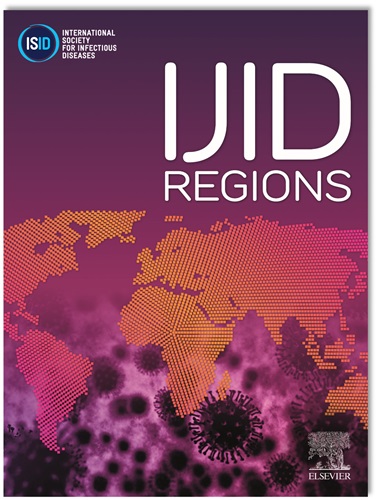Innovative methodological approach to assess dengue transmission: findings from the SERODEN study in Africa
IF 4.8
2区 医学
Q1 INFECTIOUS DISEASES
引用次数: 0
Abstract
Introduction
A limited number of dengue seroprevalence surveys have been conducted across Africa, with only 21 studies reported to date. Implementing new surveys to assess dengue transmission can be costly, time-consuming and resource intensive. In SERODEN we developed new simulation-based methods to calculate the optimal number and age-distribution of existing blood samples –collected in the context of previous household and community-based surveys, most notably against SARS-CoV-2 – to be tested for dengue. We used three different assays, namely the enzyme-linked immunosorbent assay (ELISA) IgG type 1-4, ELISA IgG NS1 type 1-4 and Plaque Reduction Neutralization Test (PRNT) for the 4 dengue serotypes, to characterise age-specific seroprevalence and dengue transmission intensity in 19 locations across Senegal, the Democratic Republic of the Congo (DRC), and Ghana.
Method
We designed a simulation-based framework to inform serosurvey design when leveraging existing blood samples. We also developed a Bayesian approach to combine the results obtained from the different assays in unifying age-stratified seroprevalence and force of infection estimates, estimating and accounting for the tests’ specificity and sensitivity.
Results
Our simulation-based framework identified the optimal sample sizes and age-distribution of the available blood samples, and overall, we reduced the total number of samples required for testing by 20%. The age-group prioritised for testing depended on the expected transmission intensity, with younger age-groups targeted for testing in high transmission settings. By combining multiple tests, including IgG ELISA type 1-4, ELISA IgG NS1, and PRNTs, we were able to quantify the specificity and sensitivity of each test and the dengue transmission in different African settings.
Discussion
Our results unveiled significant heterogeneity in dengue transmission both within and across countries and underscored the endemic nature of dengue transmission in Senegal, DRC, and Ghana. The methods developed in the SERODEN study demonstrates the feasibility and benefits of utilising existing blood samples for the implementation of dengue serosurveys.
Conclusion
By leveraging existing resources and combining different tests, we can provide valuable insights into dengue transmission intensity in Africa, which sheds new light on the dengue infection burden and can help inform dengue surveillance.
评估登革热传播的创新方法:非洲SERODEN研究的结果
在非洲各地开展了数量有限的登革热血清流行率调查,迄今仅报告了21项研究。实施新的调查以评估登革热传播可能成本高昂、耗时且资源密集。在SERODEN中,我们开发了新的基于模拟的方法来计算现有血液样本的最佳数量和年龄分布,这些样本是在以前的家庭和社区调查中收集的,尤其是针对SARS-CoV-2的调查。我们使用三种不同的检测方法,即酶联免疫吸附试验(ELISA) IgG 1-4型、ELISA IgG NS1 1-4型和斑块减少中和试验(PRNT)检测4种登革热血清型,以表征塞内加尔、刚果民主共和国(DRC)和加纳19个地点的年龄特异性血清患病率和登革热传播强度。方法我们设计了一个基于模拟的框架,在利用现有血液样本时为血清调查设计提供信息。我们还开发了一种贝叶斯方法,将来自不同检测的结果结合起来,统一年龄分层血清阳性率和感染力估计,估计和考虑检测的特异性和敏感性。我们基于模拟的框架确定了可用血液样本的最佳样本量和年龄分布,总体而言,我们将测试所需的样本总数减少了20%。优先进行检测的年龄组取决于预期的传播强度,在高传播环境中针对较年轻的年龄组进行检测。通过结合多种检测,包括IgG ELISA 1-4型、ELISA IgG NS1和prnt,我们能够量化每种检测的特异性和敏感性以及登革热在不同非洲环境中的传播。我们的研究结果揭示了登革热传播在国家内部和国家之间的显著异质性,并强调了登革热传播在塞内加尔、刚果民主共和国和加纳的地方性。serden研究中开发的方法证明了利用现有血液样本实施登革热血清调查的可行性和益处。结论通过利用现有资源并结合不同的检测方法,我们可以对非洲登革热传播强度提供有价值的见解,从而对登革热感染负担有新的认识,并有助于为登革热监测提供信息。
本文章由计算机程序翻译,如有差异,请以英文原文为准。
求助全文
约1分钟内获得全文
求助全文
来源期刊
CiteScore
18.90
自引率
2.40%
发文量
1020
审稿时长
30 days
期刊介绍:
International Journal of Infectious Diseases (IJID)
Publisher: International Society for Infectious Diseases
Publication Frequency: Monthly
Type: Peer-reviewed, Open Access
Scope:
Publishes original clinical and laboratory-based research.
Reports clinical trials, reviews, and some case reports.
Focuses on epidemiology, clinical diagnosis, treatment, and control of infectious diseases.
Emphasizes diseases common in under-resourced countries.

 求助内容:
求助内容: 应助结果提醒方式:
应助结果提醒方式:


